Why the Modi Government's 'Positivity' Narrative on COVID-19 Vaccination Plan Doesn’t Add Up
If the Government of India is to be believed, Indians have much to celebrate – and be positive about – these days. That sounds good, until you scratch at the surface of the its claims.
“Celebrate the power of positivity and the strengths of 130 crore Indians” – Prime Minister Narendra Modi exhorted in a tweet. There should be “better communication” of the government’s “positive” work – so went the message to officials of the Government of India (GoI) during an official workshop. Counter the “one-sided narrative” against India in the global media, Indian embassies and high commissions were instructed by the minister for external affairs.
As dead bodies float around in the holy Ganges, as people die for lack of oxygen or ICU beds, as crematoriums run out of space for funerals, and as the “pharmacy of the world” runs aground for lack of vaccines, the Government of India (GoI) is literally ducking for cover. The oft-employed anti-national tag to silence those raising questions is long past its expiry value. So, a fresh spin is in order. “Be positive.” Do not spread “negativity”.
But positivity cannot be manufactured from nowhere. To be effective, it needs to be based on facts, and on truth. Given the extraordinary failure of planning and a total lack of engagement with the crisis, all effort to spread positivity has ended up being based on half-truths and exaggerations. This is precisely what India has witnessed over the many evening press conferences of the GoI on the pandemic.
I watched the government's press conference of May 13, 2021. A good portion of it was intended to instil positivity about India’s vaccine policy and plans. But a close perusal of the statements and the slides presented there actually confirms just how dire the situation is.
Also read: India's COVID-19 Crisis Is an Injustice, Not a Misfortune
1. Meaningless claim on share of global vaccinations
The press conference began with Figure 1 below. V.K. Paul, member of the NITI Aayog, presented Figure 1 and claimed that of all the vaccine doses given in the world, 13% were given in India. What does this figure of 13% mean? Nothing. But his voice modulation changed with an emphasis when he said 13%, as if it was something significant. You think of it again. You check the share of India’s population in the world population. It is about 18%. The share of vaccines administered is at least five percentage points lower than the share in world population. Seen from this angle, the record is poor. Why the emphasis then?
You think harder. The prime minister had claimed that “India [is] running world's largest COVID-19 vaccination drive”. You look at Figure 1 again. Even in absolute terms, this claim is untrue as on May 13, 2021. China and the United States had given more doses of vaccines than India, even though the population of the US is smaller than India’s. That is when Paul clears the air on the reason for the emphasis. He says: “Desh ke liye, ye jo narrative hai, positive narrative jo hai, desh ke liye garv karne wala jo narrative hai, yeh bhi ek sachai hai [For the country, this narrative, the positive narrative, the narrative that makes you proud of the country, that is also a truth].” You see, it was not about facts; it was about positivity.
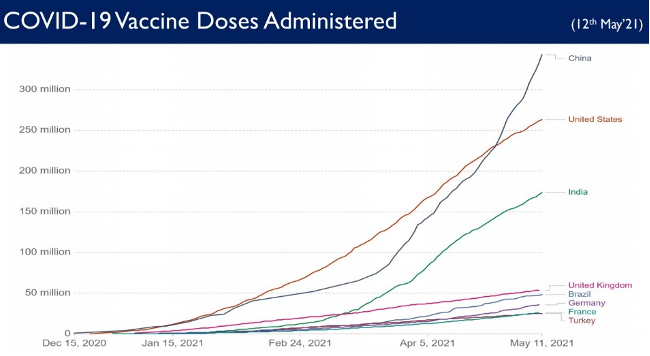
Figure 1 from the GoI presentation, dated May 13, 2021.
What is the reality? Normalised to population size, i.e., number of doses administered per 100 persons, India’s performance in vaccination coverage was extremely poor as on May 13, 2021 (see Figure 2). The number of doses administered per 100 persons was more than 100 in Israel and UAE, 85 in Chile, 81 in the United Kingdom, 79 in the United States, 46 in Germany and 25 in China. For India, the corresponding figure was just 13. There is no garv in this graph. For that reason, we will never be shown such a graph.

Figure 2, dated May 13, 2021.
2. Meaningless comparison on 'number of days' taken to reach 170 million vaccinations
The next graph in the presentation was equally amusing (see Figure 3). This is a graph that finds a place in every press conference: number of days taken to reach “x” number of vaccinations. We are told that India reached the 17 crore mark in 114 days, while the United States took 115 days. This is presented as a matter of success, which helps spread the spirit of positivity even in dire times.
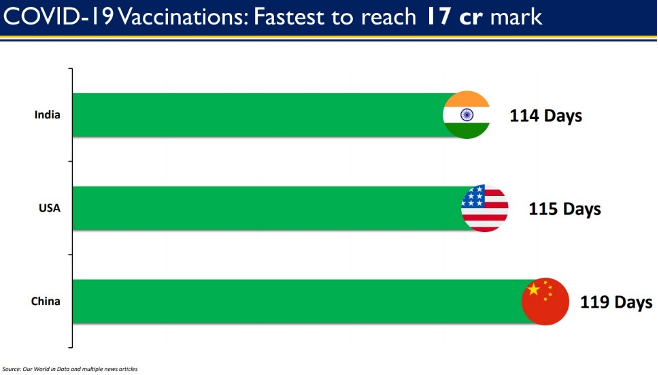
Figure 3.
However, a closer look shows this too is meaningless. The share of people who received at least one dose of the vaccine in the US was about 46% on May 12, while it was only about 10% in India. As countries like the US near the 50% mark, progress will surely slow down for multiple reasons; difficulties in reaching remote and rural areas, vaccine hesitancy and encounters with anti-vaxxers are some of the many reasons. Moving from 50% to 60% in the US will be slower than moving from 10% to 20% in India; in fact, it should be a cakewalk in India given the millions waiting to get an appointment in the CoWIN app. Yet, India moves as slow as a tortoise. Thus, while Figure 3 is put out as a measure of success, it actually reveals a problem.
Also read: Modi's Gamble, and How Many Lives It Will Cost
3. Misleading claim on actual vaccine availability in India
Then came another slide on vaccine availability in India (see Figure 4). There was no new information in this table other than what earlier presentations had already told us. But here again, it was a matter of emphasis. The figure of 35.6 crore was emphasised even though this was a cumulative figure from January 2021 running up to July 2021. In addition, 16 crore doses are ordered by states and private hospitals for delivery between May and July 2021. So, the total is 51.6 crore doses. Left to itself, this slide leaves a layman with the impression that the GoI has done a commendable job. Is it true?
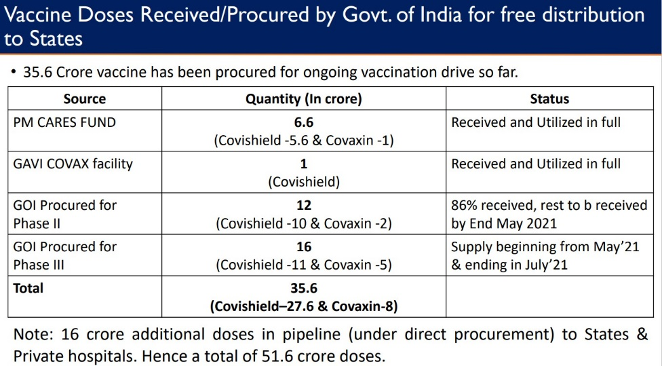
Figure 4.
The problem with Figure 4 is that there is no messaging on whether this is an adequate quantity or not. I had addressed this matter in an article written for Scroll.in on May 11, 2021; I shall refer readers to Table 1 in my article. What is important is to see the doses available with the GoI, state governments and private hospitals over three months viz., May, June and July 2021. Table 1, reproduced below as Figure 5, shows the following.

Figure 5.
The table in Figure 5 tells us that the GoI would have an average entitlement of 21.4 lakh vaccine doses per day in May, June and July. However, the average production capacity of vaccines in India in May 2021 is only about 23 lakh doses per day, as a later slide in the same press conference showed. Thus, of the 23 lakh doses per day, the GoI would buy 21.4 lakh doses per day. After setting aside a part of the production capacity for private hospitals, the share of doses left for the State governments between May and July 2021 will be miniscule. Even if we liberally fix India’s production capacity at 28 lakh doses per day, the situation remains largely the same.
In other words, the “16 crore additional doses” cited for states and private hospitals is an irrelevant number. 16 crore doses for 3 months mean 17 lakh doses per day. To meet this demand from states, India should produce at least 38 lakh doses per day. However, we do not produce that. States may ultimately receive 16 crore doses, but only some months after July 2021. Thus, there is a world of difference between the impression created through Figure 4 and the reality depicted in Figure 5.
4. Projecting '2 bn doses' based on untested vaccines, unexplained production increases
The star of all slides was only to follow (see Figure 6). This table showed the “emerging vaccine availability” in India between August and December 2021. It showed that India would literally be flooded with vaccines in this period totalling 216 crore doses over five months. This implies a jump, rather a major leap, of production capacity/availability from about 23 lakh doses per day to about 1.4 crore doses per day – a six-fold rise!
To begin with, most vaccines referred to in Figure 6 are only in the trial stage and we do not even know if they would pass all the stages of tests. Assuming they do pass, it is not at all clear if production capacity exists to fulfil these targets.
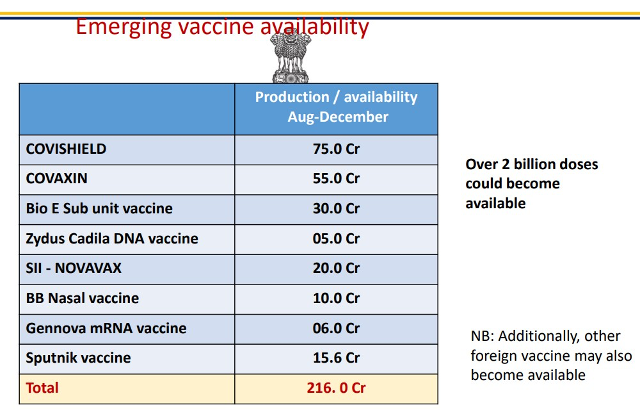
Figure 6.
The claim is that the Serum Institute of India (SII) will produce 95 crore doses in five months (75 crore doses of Covishield and 20 crore doses of Novavax/Covavax). In other words, SII’s capacity would rise about three-fold from the present 21-22 lakh doses per day to about 64 lakh doses per day. Let us remember that SII has already been struggling to meet an earlier promise of producing 33 lakh doses per day by July 2021; this is partly due to an accidental fire incident in SII in early 2021 and partly due to export restrictions in the US with respect to special pumps and filtration units needed to make vaccines. It is, thus, highly unlikely that SII would produce 64 lakh doses per day before December 2021.
The other claim in Figure 6 is on Covaxin. If 55 crore doses of Covaxin are to be produced over five months, the production capacity should rise from the present five lakh to seven lakh doses per day to 37 lakh doses per day. Bharat Biotech is on record stating that their capacity may rise to 19 lakh doses per day, but only by December 2021 or January 2022. The GoI’s affidavit to the Supreme Court states that the production capacity of Covaxin will rise from three lakh doses per day to 33 lakh doses per day "over the next 8-10 months". So, by all possibilities, we can produce Covaxin at around 33 lakh doses per day (or 37 lakh doses per day, as in the slides of the GoI) in December 2021 or January 2022. Not before that.
Also read: Why Is the Modi Govt Closing Forums of Public Accountability During a Pandemic?
The rest of the Covaxin doses promised in Figure 6 must come from the three public sector units that are provided with new licenses. However, of these three units, Haffkine Institute will be able to produce the first batch of vaccines not before six months after April 2021, if not 12 months. The same holds true for the other two units also. The GoI has set aside Rs 200 crore as a grant-in-aid to these three units. At the same time, the GoI's affidavit says that “grant-in-aid has been recommended; however, disbursements have yet to be made”. In other words, no payments have been made as yet – a sure indication of forthcoming delays.
So, where are the rest of the Covaxin doses going to come from? There is zero clarity.
It is quite possible that some additional doses of Covishield, Covaxin and other vaccines like Sputnik V would start trickling in between August and December 2021. However, the numbers cited in Figure 6 are unrealistic and wrong. It is important that in its efforts to spread positivity, the GoI should not disseminate falsehoods. Positivity would be best served by the dissemination of truth, how much ever unpalatable.
5. Reality is daily vaccine doses are falling, not rising
The key story that emerges from the vaccine policy of India in April and May is a huge shortage of vaccines, because of which the number of doses administered fell from around 42 lakh doses per day in early April to 27 lakh doses per day by end-April and 23 lakh doses as on 13 May (see Figure 7, for a plot of seven-day moving average of daily doses). In effect, our daily vaccination rate has closely followed our daily production capacity after mid-April.
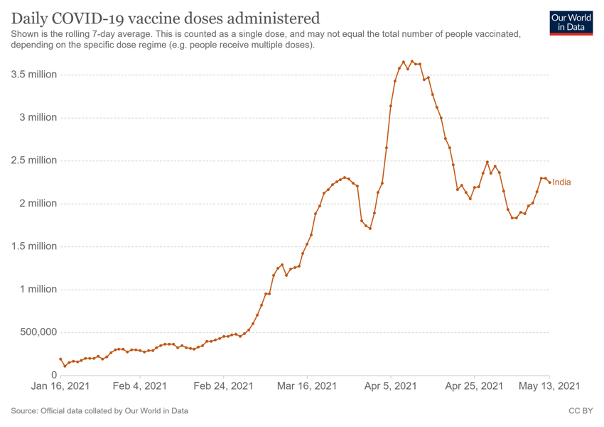
Figure 7.
The GoI should, first, provide Indian people with a clear explanation for why this fall in daily vaccination rate happened. That might be a good starting point for an honest conversation between the government and people, based on facts and truth. Bombastic claims and projections should be avoided.
R. Ramakumar is Professor, Tata Institute of Social Sciences, Mumbai.
This article went live on May fifteenth, two thousand twenty one, at forty-four minutes past eleven in the morning.The Wire is now on WhatsApp. Follow our channel for sharp analysis and opinions on the latest developments.




